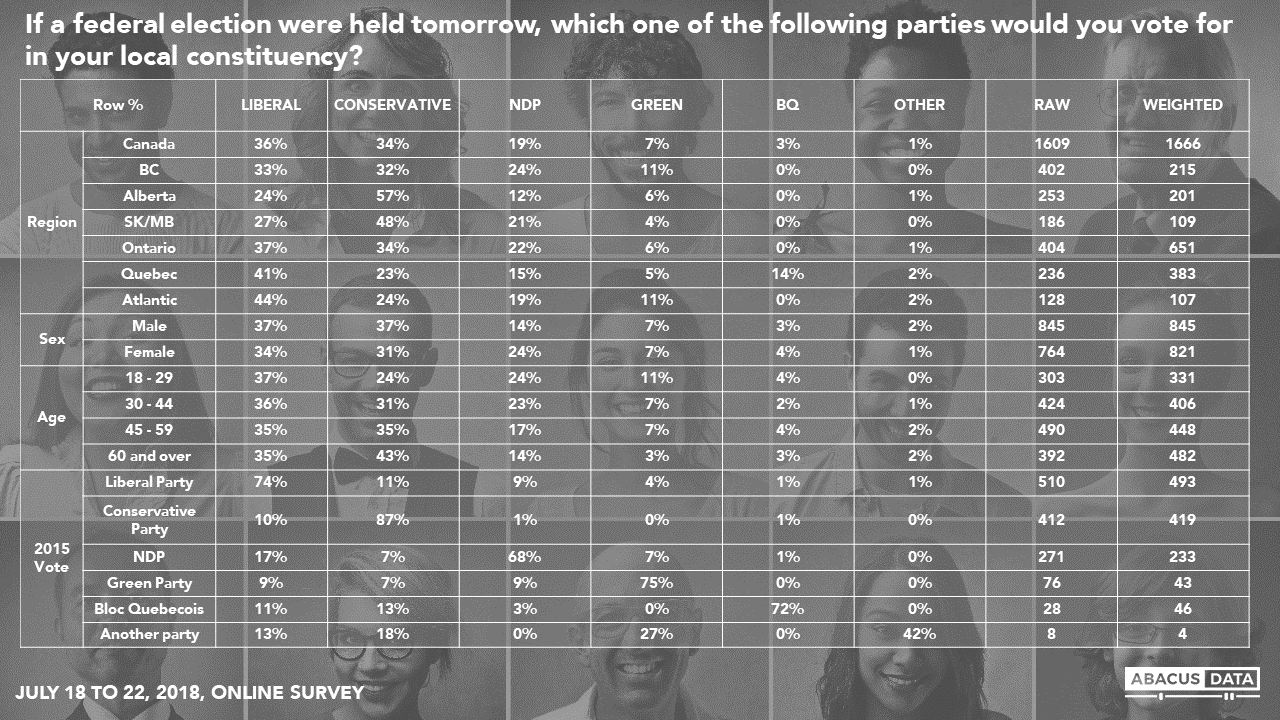Liberals and Conservatives neck and neck as the race to 2019 takes shape
July 31, 2018
With a little over a year to go before the start of the 2019 federal election, we polled 2,000 Canadian adults last week about how they are seeing their political choices.
Here are the highlights as we see them:
THE SITUATION TODAY
Today, 43% say they would prefer to see the Liberals re-elected next year, and 57% would prefer a change in government. Last July 50% said they would prefer the Liberals to be re-elected. This shift means the landscape is more competitive today, but worth bearing in mind that the Liberals were elected with just under 40% of the vote in 2015.

Today 52% say they would consider voting Liberal, 51% would consider voting Conservative up and 49% are open to considering the NDP, an unusually close pattern among the three parties.

If a vote was held tomorrow, 36% would vote Liberal, 34% Conservative, and 19% NDP. We see competitive races in Ontario and BC (Liberals and Conservatives), while the Liberals lead in Atlantic Canada and Quebec and the Conservatives have a lead on the Prairies.




Today, 42% say the country is heading in the right direction, 44% approve of the job being done by the federal government 43% have a positive impression of Prime Minister Trudeau.



Positive impressions of Conservative leader Andrew Scheer are on the rise but so are his negatives. Impressions of Jagmeet Singh are moving more decidedly negative with his negatives now seven points higher than positives.


THE CHALLENGE FACING THE INCUMBENTS
We explored further among the 57% who say they are inclined to want a change in government in October 2019, and here’s what we found:
When asked if the government could do anything to change their mind, 14% (or 8% of the population overall) said “yes, for sure” while another 33% (19% of the population overall) said “there could be”. In other words, the number of “hard change” voters is about 30% in total.

Among voters who say they are inclined to vote for a change but could be persuaded to vote to re-elect, 30% voted Liberal in 2015, only 15% would today. 35% voted CPC – 41% would today. 26% voted NDP – 29% would today.

We asked people to tell us which of several potential factors had been contributing to their desire to change the government next year. Overall, fiscal and tax issues rank high in importance as do immigration and refugees issues and the PM’s trip to India.

However, what is more instructive is to look at separately at the change voters who are leaning toward the NDP and Conservatives. Among current NDP voters who say they could be persuaded to re-elect the Liberals, the Trans Mountain pipeline is at the top of the list of grievances with the government along with electoral reform and fiscal management.
Among those who say they will vote Conservative but could be persuaded to vote to re-elect, debt/deficits, immigration and refugees and the PM’s trip to India rank one-two-three followed by carbon pricing, taxes, and economic policies. Conservatives are much more likely to be concerned with the PMs vacation in the Caribbean compared to New Democrats.

THE UPSHOT
Bruce Anderson: “For the most part, polling during a government’s mandate reflects how people are reacting to the government – and not so much about its competitors. As Canada moves closer to the 2019 election, people will start to evaluate not only the incumbents but the alternatives.
Today’s numbers show ample opportunity for the Conservatives to have a successful election next year, but also show that more people are satisfied than dissatisfied with the direction of the country, the performance of the government and the Prime Minister. Regional combats in Ontario and BC are shaping up to be where the fight will be won or lost – with plenty of seats on the line, and lots of votes will be up for grabs. A considerable number of voters who’ve shifted rightward from the Liberals aren’t particularly dug in or angry. And many of those who have drifted left may find themselves faced with a tough conundrum – voting to punish the Liberals for the Trans Mountain pipeline might risk electing a government that would kill environmental measures such as carbon pricing.”
David Coletto: “The Liberals are still well positioned about a year before the next election begins. But some storm clouds are approaching including Conservative gains in Quebec, weaker support among older voters, and rising concerns about immigration and refugees, especially among Conservative-leaning voters who are open to voting Liberal.
The pools of accessible voters for all three parties are closer in size than they have been since the last election and increasing volatility in Ontario and Quebec means predicting what will happen over the next 12 months is increasingly difficult.
We can no longer say that the Liberals are the front-runners. But we are seeing a public opinion environment that is more competitive and one where the issue space is forming around fiscal management, immigration and refugees, and energy and the environment.”
Methodology
Our survey was conducted online with 2,000 Canadians aged 18 and over from July 18 to 22, 2018. A random sample of panelists was invited to complete the survey from randomly selected Canadian adults who are members of the Maru Voice Canada online panel.
The Marketing Research and Intelligence Association policy limits statements about margins of sampling error for most online surveys. The margin of error for a comparable probability-based random sample of the same size is +/- 2.2%, 19 times out of 20. The data were weighted according to census data to ensure that the sample matched Canada’s population according to age, gender, educational attainment, and region. Totals may not add up to 100 due to rounding.





